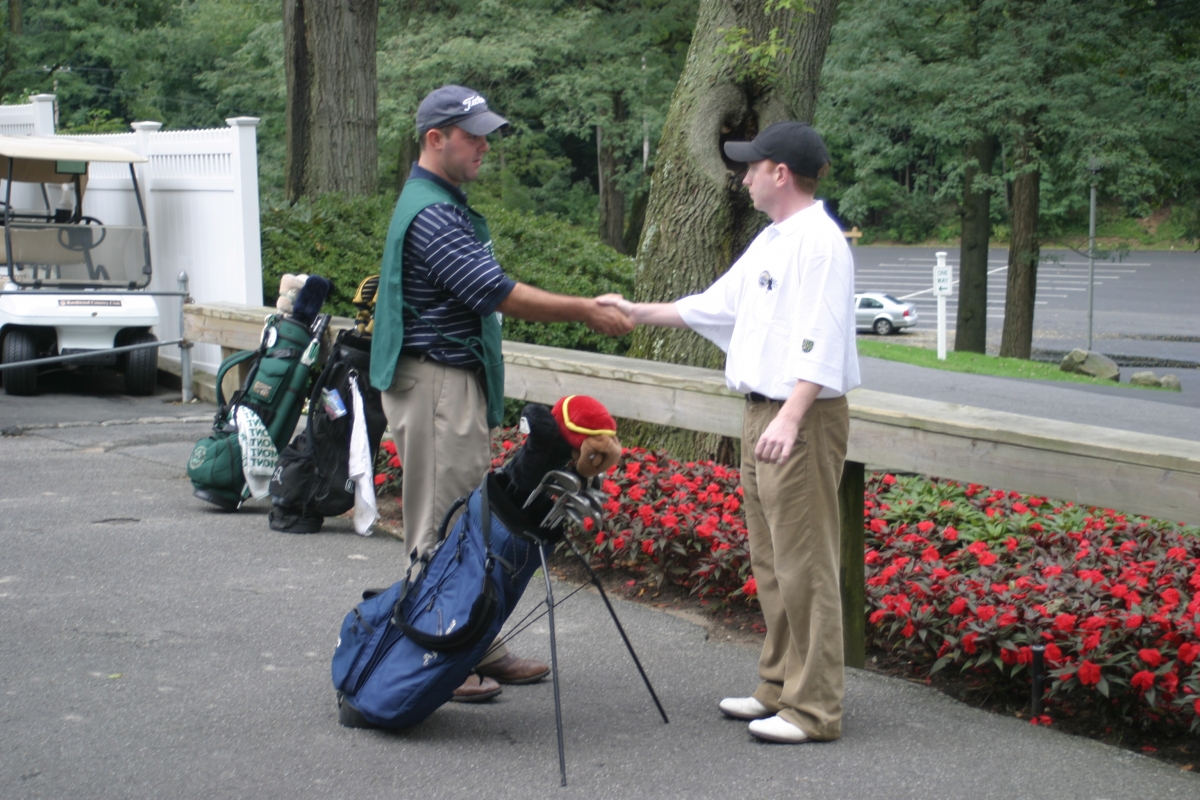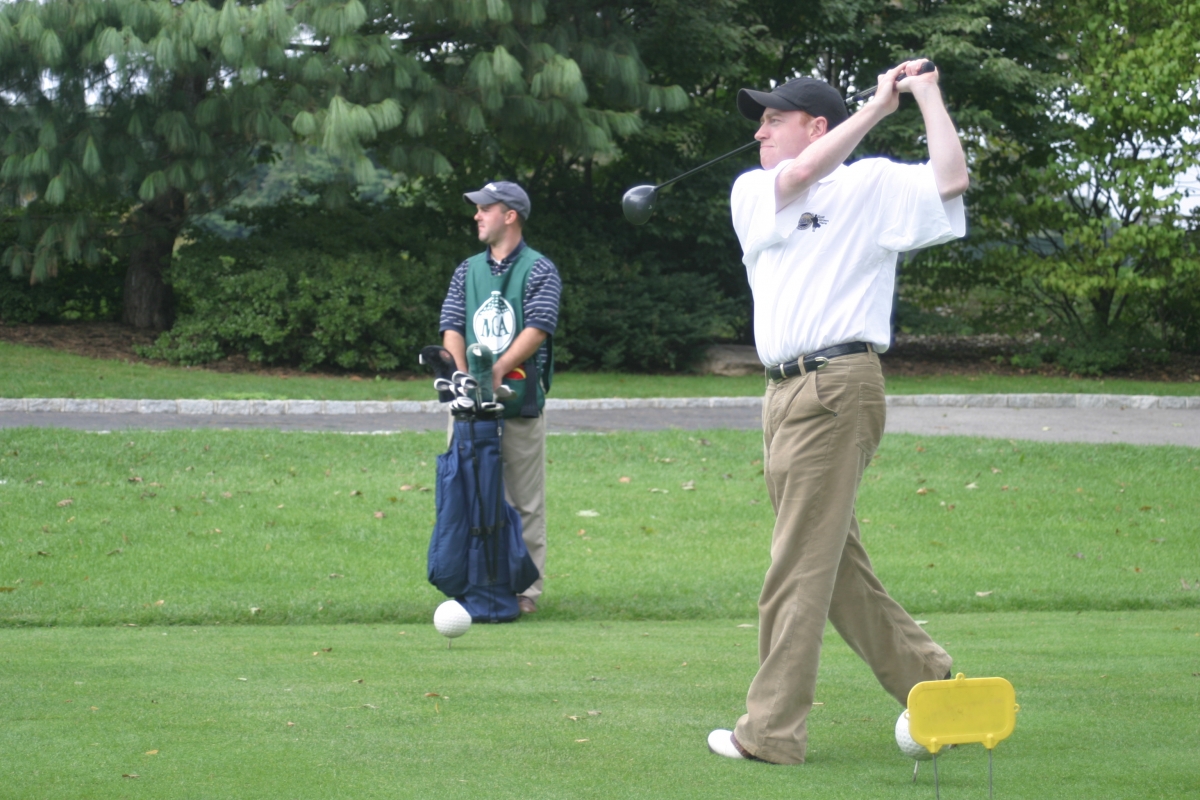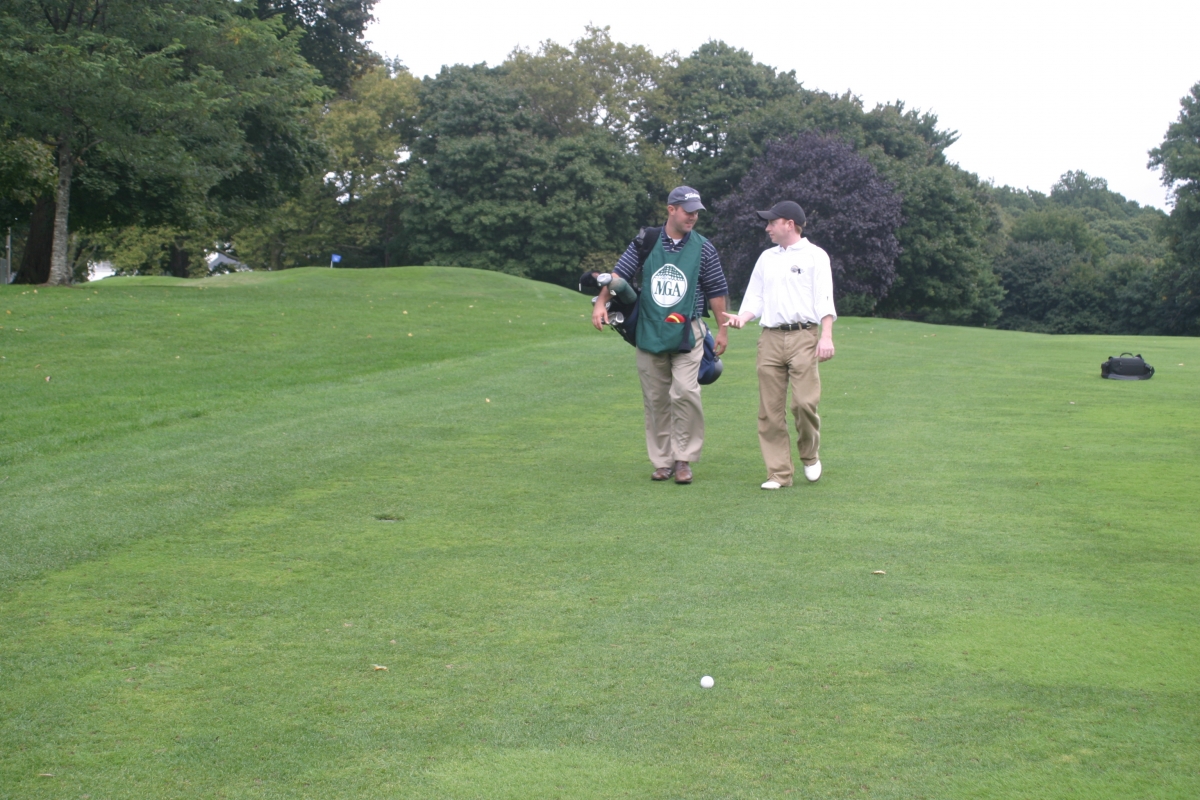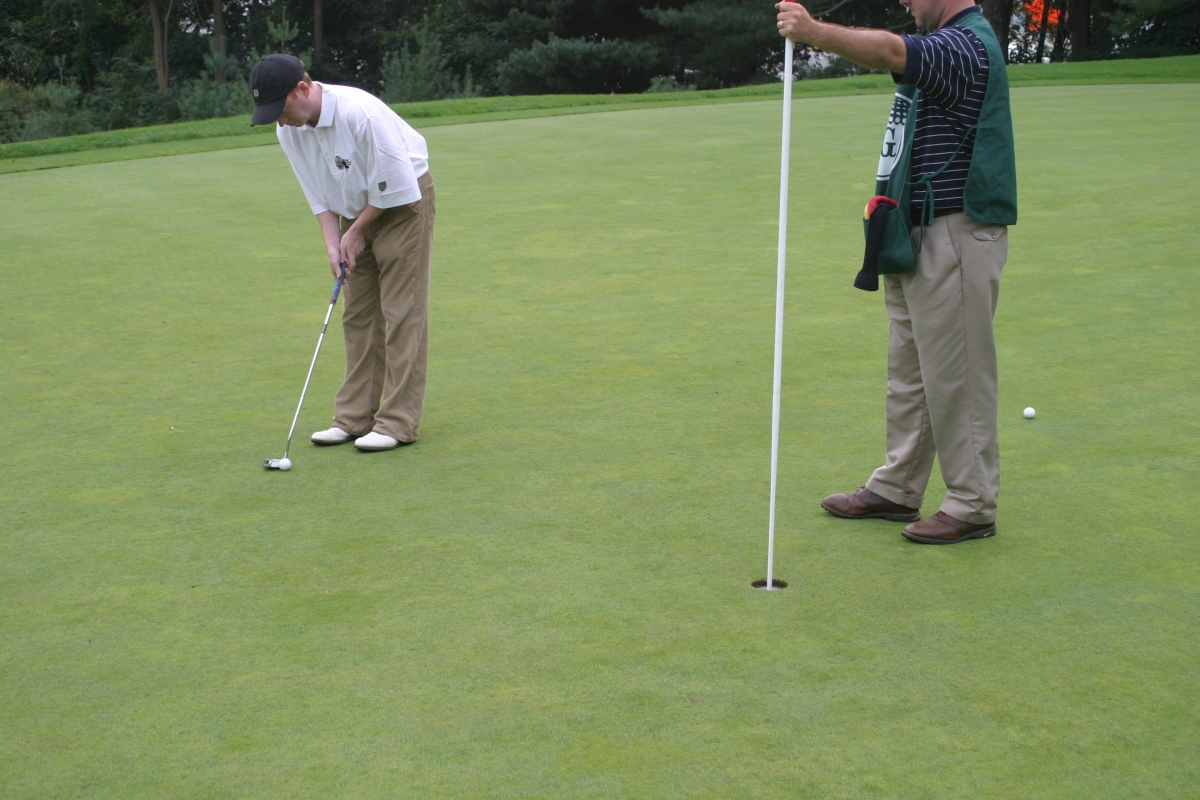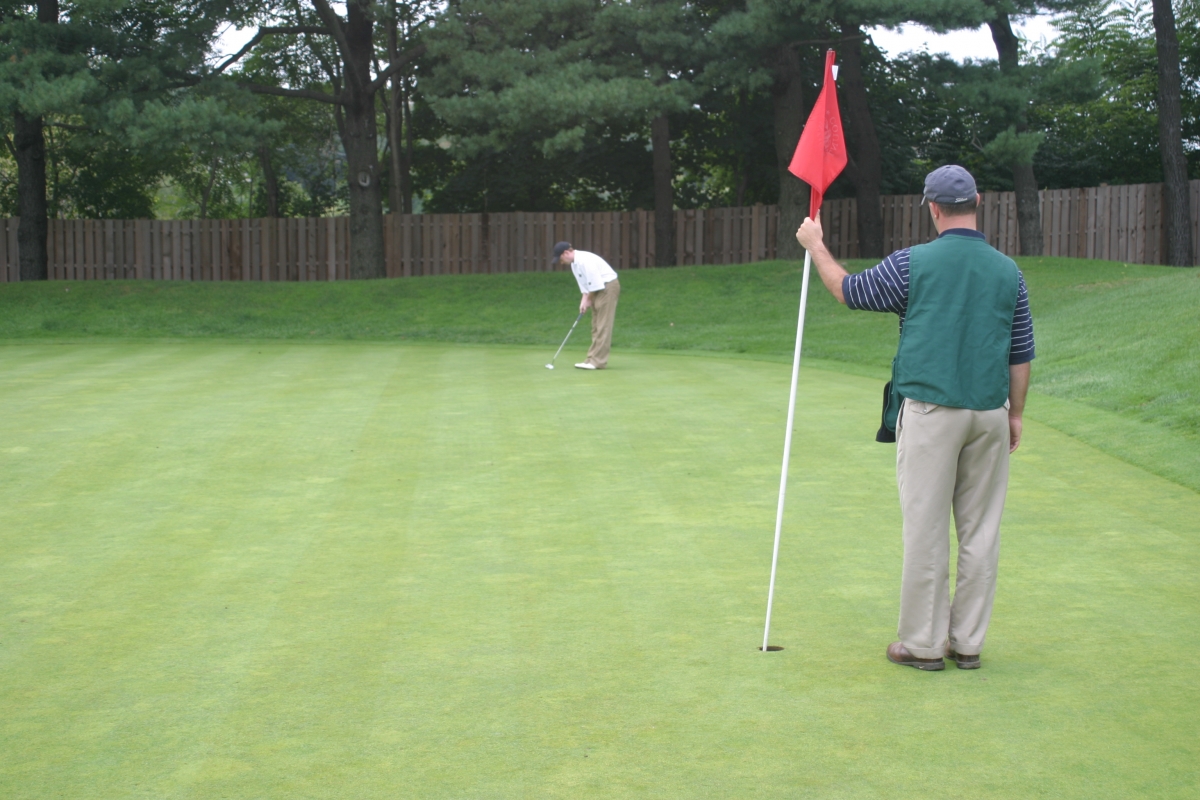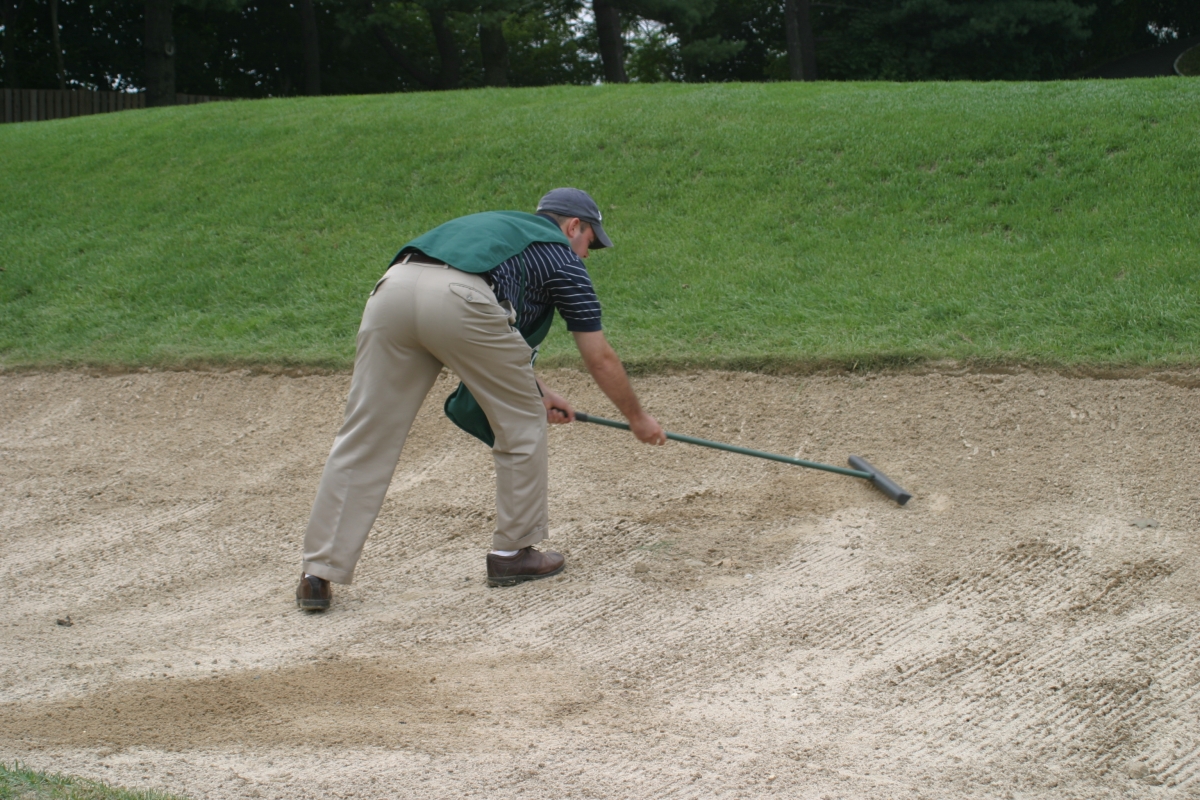INTRODUCTION
Caddieing is a great job. The money is good, you work outdoors and have an opportunity to meet successful and influential people, and you may even earn a college scholarship.
Caddieing is an important job. It is part of golf’s heritage and part of its future. It is also a great way to learn the game of golf.
This is YOUR guide. Study it and ask your Caddie Manager or Golf Professional to explain anything that is not entirely clear. Knowledge of its contents will help make you a better caddie and valuable to the club and the golfers you serve.
This guide is published by the MGA Foundation. We believe caddies are an important part of the game of golf and together we are working to help keep young people like you active and interested in this great sport.
THE CADDIE MANAGER
The Caddie Manager is pivotal to the golf club industry with many responsibilities, which can materially affect the welfare of the club.
The Caddie Manager is charged with the task of recruiting and scheduling caddies. He must also communicate effectively with the Golf Professional and other club staff members and can have a significant influence on the extent to which the membership enjoys the game.
A professionally trained, knowledgeable and courteous group of caddies and a well-managed caddie program can help a club deal more effectively with slow play, significantly add to the number of enjoyable rounds of golf and enhance the club’s overall image of a first class operation.
Each club will have its own set of procedures for caddies, so be sure you follow them. However, do not be afraid to ask your Caddie Manager questions, not only about your job on the course, but about:
- How to check in after arriving and await an assignment?
- Dress code?
- Where to go and what to do when given an assignment?
- How you will be paid and what to do when you complete an assignment?
- College scholarship information and opportunities?
ON THE TEE
- Check in as directed, then go to the caddie area, and wait for an assignment.
-
When assigned a player’s bag, go to the 1st tee, or designated area with the bag and adjust the strap to a comfortable position. Carefully count the clubs in the bag (the rules permit a maximum of 14 clubs). If the player has more or less than 14 clubs, tell the player.
-
Arrange the clubs in the bag so that the driver, woods and hybrid clubs are in the top section; the iron clubs numbered 3-8 are in the middle section; and the remainder of the clubs in the bottom section. NOTE: Keep the covers on the woods, hybrids, and putter.
-
Learn how to pronounce the player’s name, introduce yourself when the player arrives and answer politely in reply to questions. Tell the player you are a new caddie.
-
Take note of the brand name and number on the golf ball your player is using (i.e. Callaway, Titleist, etc.).
-
When the player is hitting, stand off to the side where you can watch the ball in flight and see where it lands. Be sure you are not in an area where you could be hit by the ball or where you might be distracting the player. If the sun is in your eyes, move to a position where you will be able to follow the flight of the ball.
- After the round and club cleaning, take the clubs where directed by the player and report back to the Caddie Manager. If you are not waiting for another assignment, go home.
Introduce yourself to the player and tell him you are a new caddie. On the tee, position yourself where you won’t distract the player and where you can follow the flight of the ball.
IN THE FAIRWAY
-
Walk alongside or ahead of the player; don’t lag behind.
-
Walk with your hand over the clubs so they do not rattle.
-
When proceeding from the tee, move quickly forward to where the first ball landed. If it is not your ball, stand back and out of the way while any ball farther away is played, then proceed to your ball.
-
When you reach your player’s ball, stand the bag about three feet to the right of the ball. After the player has selected his club, quickly move out to a position at least ten feet to the right of the player and concentrate on watching your player’s ball in flight.
-
After spotting where the ball ended up, be sure the divot is replaced (if the player does not replace it, you must).
-
Watch the flight of all balls in your group and don’t walk or talk when any player is hitting. Always be careful not to be in a position where you could be hit by a golf ball. If a ball in flight may hit someone, yell “FORE”!
- After the player plays his shot, take the club from the player and clean it before returning it to the proper section of the bag. If the player’s ball ends up on the green, hand him his putter, otherwise, move quickly to the next shot.
Move quickly from the tee and walk alongside or ahead of player. Don’t lag behind. After reaching player’s ball, stand bag about 3 feet to the right and allow player to select a club.
ON THE PUTTING GREEN
The putting green is an important area and the caddies should be especially careful in handling their duties here.
- Hand your player his putter as soon as his ball is on the green.
- If you are going to tend the flagstick, lay the bag down out of the player’s way, off the green on the side nearest the next tee. If you are not going to tend the flagstick, go directly to the next tee.
Attending the Flagstick
-
The person whose ball is farthest from the hole putts first. Learn to judge which ball is farthest from the hole.
-
Tend the flagstick only if asked to do so or if the ball about to be putted is on the green.
-
When walking on the putting green, be aware of the position of all the balls on the green and avoid stepping in “the line” of a putt from any of the balls.
-
When you get to the flagstick, check to make sure that it is not stuck in the hole.
-
Stand so that your feet are at least two feet from the hole and your shadow does not cover the hole or cross the line of putt. If you can reach the cloth at the top of the flagstick, hold it so that it does not flap in the wind.
-
Pull the flagstick out of the hole as soon as the player hits the ball and be sure that the putted ball does not hit you or the flagstick.
- When returning the flagstick to the hole, use two hands to make sure the stick fits completely into the hole and to avoid damaging the edge of the hole.
Left: INCORRECT: Do Not stand on another player’s “line of putt” while tending the flagstick; note ball behind caddie. Right: CORRECT: When tending the flagstick correctly, your body (or shadow) will not be in the “line of putt”.
IN THE ROUGH AND PENALTY AREAS
-
If your player hits a ball towards the rough or a penalty area, watch it carefully until the ball comes to a complete stop. Mark the position of the ball with some permanent object like a tree or large rock so that you will be able to find the ball.
-
When you find the ball, do not touch it unless specifically instructed by the player.
-
If a ball is hit Out of Bounds, tell the player immediately but don’t pick it up until the player tells you to do so.
- If your player hits a ball into a bunker, wait until after the player has hit his shot before entering the bunker to smooth the footprints or other irregularities. Never take the golf bag into the bunker with you. Set the bag down and walk into and out of the bunker using the same path the player did. Be sure not to disturb players when raking especially around the greens. After smoothing all the footprints, leave the rake outside the bunker and lying in the direction of the hole.
After your player plays a shot from the bunker, carefully smooth footprints and other irregularities.
TEAMWORK
Golf is a game traditionally played in groups of four people requiring the services of two or more caddies. Your ability to communicate with the other caddies in your group and work as a member of a team will help your ability to effectively service the members of your group and help the pace of play immeasurably. It will also make your job easier, more fun and could result in better tips.
- Caddies should share the job of attending the flagstick. In general, the caddie whose player(s) are on the green first attends the flagstick. The other caddie(s) should rake bunkers as required and prepare to forecaddie on the next hole if appropriate.
Carrying Double (Two Bags)
- Both caddies should watch the flight of all four balls (not just their players’) and mark the position of any balls which come to rest off the fairway.
- When visibility is a problem or trees surround the hole, caddies should position themselves so that they will most effectively be able to follow the flight of the balls.
- When each caddie has one player to the left of the fairway and the other to the right, they should switch bags to cut down on the walking back and forth and save the players time.
- When carrying double and each caddie has one player on the green and one in the bunker, one caddie should rake both bunkers while the other caddie handles the flag.
ATTENDING CARTS
Caddies will often be assigned to attend players riding carts. The duties are essentially the same as when carrying, except for bag and club handling. You must hustle to keep up with the cart, but this is not difficult when you have no bags to carry. Generally, the players handle their own clubs, except for the putters—but some may require more service than others.
- When assigned to a cart, place the bags securely on the cart (the Caddie Manager will demonstrate). Find out which of the players will drive and put the driver’s bag on the driver’s side.
- Hand the players their drivers on the first tee, but from then on, they will generally handle their own drivers. Take the putters with you before leaving the first tee. On each green thereafter, you will give the players their putters and take any clubs they have in hand. As they walk off the green, you will retrieve the putters and hand the clubs back for the players to place in the bags on the cart. If a player eludes you in exiting the green, you must return any clubs you are holding back to the bag and retrieve the putter from the player (or the bag). Do this as soon as possible before you reach the next green.
- Check with the players to find out if they want you to attend them at the cart after they’ve played from the tee—or if they prefer that you run ahead to position yourself for the landing area of their next shot, this is called spotting or fore caddieing.
- If you attend a cart while carrying two bags, you will handle the riders’ putters and clubs, as above, but you will not be able to give as much service to the riders as you will to your walkers. Nevertheless, try to rake as many bunkers for them as you can, and do your very best to spot all balls headed for trouble.
- Players will sometimes ask you to move or drive carts for them. If you are under 16 years old, you must tell them you are underage and not permitted to drive a cart.
ROLE OF THE PLAYER
The MGA believes the player plays a major role in maximizing the effectiveness of a caddie. Fixing ball marks on the green, replacing divots, taking a club or two when you share a caddie with someone who has hit his ball into the rough and making sure the golf bag is not loaded with unnecessary equipment will help the caddie to keep up the pace and more effectively serve the player.
HINTS FOR HEALTH & COMFORT
Take care of your feet. Make sure your shoes are comfortable and will give you proper support and traction on grass. On wet days, wear footgear that will keep your feet dry.
Dress for the weather. Wear a waterproof jacket on rainy days. When it’s very hot, wear loose-fitting, lightweight and light-colored clothing, a golf cap or brimmed hat and good sunglasses if you have them. When it’s cold, wear layers of warm clothing, gloves or mittens and a warm hat. Always carry a sweater or windbreaker with you, except when there is no chance of the day turning cold or stormy.
Eat sensibly. Have a good breakfast. Don’t try to get through the day on a soda and a candy bar. For lunch, have a sandwich, a sports drink and a healthy snack.
On very hot days, drink lots of water, even if you’re not thirsty and seek the shade whenever possible without holding up play. Drink an energy drink such as Gatorade, rather than a soda.
PROTECTION FROM LIGHTNING
The golf course is an extremely dangerous location during thunderstorms. If you and your players are unavoidably caught in a storm out on the course, all should seek protection as fast as possible. The minute anyone sees a bolt of lightning, you have the right to seek protection, even if your players are not concerned.
Find shelter inside a building, if you possibly can (or in an automobile, or other metal-enclosed vehicle, if one happens to be nearby). Avoid small unprotected buildings, shelters or tents in high areas.
If no inside shelter is nearby, seek out:
- Dense woods—avoid isolated trees.
- Depressed areas—avoid hilltops and high places.
Avoid riding golf carts in open spaces, on hilltops and high spaces, or near isolated trees or wire fences.
Raising metal-shafted umbrellas or golf clubs above the head does increase the hazard of lightning. Do not do it.
GOLF RULES FOR CADDIES
Under the Rules of Golf, a caddie is treated as his player’s partner. The player is responsible whenever the caddie violates one of the Rules of Golf, exactly as though the player had been the violator.
As a result, it is very important that a caddie have a good knowledge of the Rules of Golf, especially those Rules that commonly occur in the course of a round.
Taking a few minutes to familiarize yourself with some of the regulations discussed here will help you avoid the embarrassment of your player being penalized.
RULES CONCERNING CADDIES
What Can I do?
Actions always allowed:
- Carry, transport and handle the player’s clubs and other equipment.
- Search for a player’s ball.
- If asked, give information, advice, & help before the stroke is made.
- Smooth bunkers or other actions to care for the course.
- Remove sand and loose soil and repair damage on the putting green.
- Remove or attend the flagstick both before and or after the stroke has been made.
- If the player asks you to, mark the spot of the player’s ball and lift and replace the ball on the putting green.
- Clean the player’s ball.
- Remove loose impediments and movable obstructions.
What Can’t I Do?
Actions not allowed:
- Standing on the line of play when a player takes their stance and makes a stroke.
- Replace a ball, unless the caddie had lifted or moved the ball.
- Drop or place a ball in a relief area.
- Decide to take relief under a rule; the caddie may advise the player to do so, but the player must decide.
General Rules to Remember (for your player):
- When taking relief, drop from knee height (NOT shoulder height).
- Search time – 3 minutes (not 5 minutes)
- If your ball accidentally moves when searching for it, replace it without a penalty.
- No penalty if your ball hits you or your equipment accidentally after a stroke.
- No penalty if your ball strikes the flagstick when you have chosen to leave it in the hole.
- Ball accidentally moves on the putting green – no penalty and replace.
- Ball marked, lifted and replaced on putting green is then moved by natural forces – no penalty, replace on original spot.
GOLF DEFINITIONS
APRON • The last few yards of fairway before and around putting green - also known as fringe.
BIRDIE • A score one stroke under par for the hole.
BLIND GREEN • One which cannot be seen when player is hitting approach shot.
BOGEY • A score one stroke more than par for the hole.
BUNKER • A hazard, commonly, but improperly, called a “sand trap”.
DIVOT • A piece of turf or sod cut loose by a player’s club when making a shot. To maintain good course conditions, divots should be replaced.
DOGLEG • A hole which does not follow a straight line from tee to green.
DRIVE • Shot played from the teeing ground, usually with a club called a “driver”.
FAIRWAY • The area of short cut grass between the tee and the green.
FLAGSTICK • The “Flagstick” is a movable straight indicator, with or without bunting or other material attached, centered in the hole to show its position.
FORE • A warning shouted to let a person know that a ball in flight may hit him or come very close.
GROUND UNDER REPAIR • Usually marked by white line painted on the ground to indicate areas of “free relief.”
HANDICAP • A number that describes a player’s level of ability.
HONOR • The right to play first.
HOOK • A shot, hit by a right-handed player, which curves to the left of the intended target.
LINE OF PUTT • Path the ball should travel on the putting green.
OBSTRUCTION • Artificial object erected, placed, or left on the course.
OUT OF BOUNDS • Ground on which play is prohibited. Usually marked by white stakes or boundary fences.
PENALTY AREA • Any body of water or other areas defined by the Committee where a ball is often lost or unable to be played.
PREFERRED LIES • A Local Rule permitting the player to improve the lie of his ball on a fairway, because of poor conditions on the course. Also referred to as “Winter Rules.”
PROVISIONAL BALL • A second ball played when the first ball might be lost outside of a penalty area, or for a ball that might be out of bounds. The player must announce it as provisional prior to playing the stroke.
ROUGH • The area of long grass left and right of the fairway.
SLICE • A shot, hit by a right-handed player, which curves to the right.
TEEING AREA • The starting place for the hole. Ball must be played from between two colored markers. (Commonly, red markers are for women’s play; white markers are for men’s; blue markers are for championship play).
10 RULES TO BE A GOOD CADDIE
-
Learn all fourteen clubs and how and when they are used.
-
Watch the flight of the ball and memorize its position once it comes to rest.
-
Make sure divots are replaced.
-
Smooth the sand in the bunkers.
-
Walk ahead of your player; don’t lag behind.
-
Don’t step in any player’s line of putt on the putting green.
-
Learn the yardage of each hole and know where the yardage markers are on each hole.
-
Handle player’s clubs and bag with care; don’t swing clubs or lean on them.
-
Don’t touch the ball while it is in play.
- Hustle, stay quiet and if you don’t know—ask!
Local Caddie Scholarship Information:
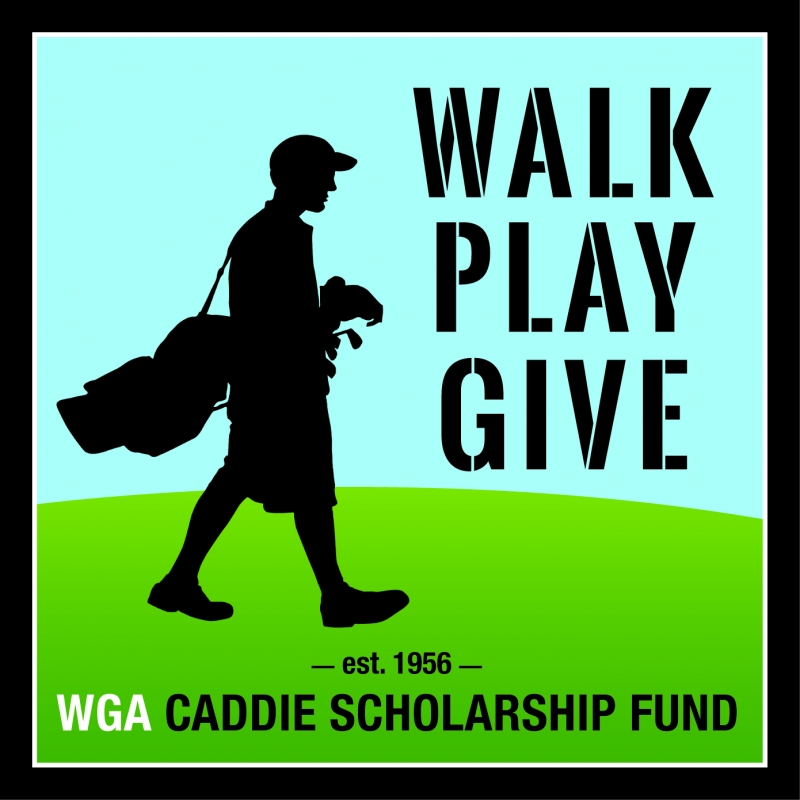
Westchester Golf Association Caddie Scholarship Fund
www.caddiescholarship.org
Contact: Johanna Gavin, Sr. Director Caddie Scholarship Funds
49 Knollwood Road, Elmsford, NY 10523
(914) 347-2340
jgavin@caddiescholarship.org

Long Island Caddie Scholarship Fund
www.longislandcaddiescholarship.org
Contact: Johanna Gavin, Sr. Director Caddie Scholarship Funds
49 Knollwood Road, Elmsford, NY 10523
(914) 347-2340
jgavin@caddiescholarship.org

New Jersey State Golf Association Caddie Scholarship Fund
www.njsga.org/caddie-scholarship
Contact: Bill King
3 Golf Drive, Suite 206, Kenilworth, NJ 07033
(908) 241-GOLF
billk@njsga.org

CSGA WIlliam Neale Scholarship Fund
www.csgsalinks.org
Contact: Richard Zanini
35 Cold Spring Road, #212, Rocky Hill, CT 06067
(860) 257-4171
rlzanini@cox.net
For any questions or information about getting started as a caddie, don't hestitate to reach out to the MGA Foundation at 914-347-4653.
